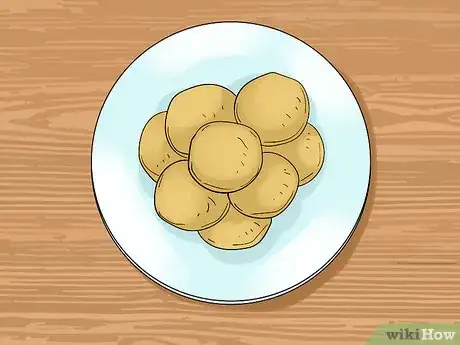This article was co-authored by wikiHow Staff. Our trained team of editors and researchers validate articles for accuracy and comprehensiveness. wikiHow's Content Management Team carefully monitors the work from our editorial staff to ensure that each article is backed by trusted research and meets our high quality standards.
There are 7 references cited in this article, which can be found at the bottom of the page.
This article has been viewed 29,102 times.
Learn more...
Bergamot oranges have a unique bitter and sour flavor, and are believed to be a cross between a lime and a sour orange. While too bitter to be eaten raw, Bergamots can be preserved in jams or marmalades. Bergamot juice and zest can also add a bright flavor to custards, cookies, and other desserts. Try substituting bergamot oranges wherever you’d use Meyer lemons, such as in marinades or dressings. You can also use a cold press expression method to make an essential oil with the peel.
Ingredients
Oyster Mushroom Salad with Apple and Bergamot[1]
- 8 handfuls of lamb’s ear lettuce, rinsed and dried (or substitute with other salad greens)
- 12 walnuts, shelled and chopped
- The juice of half a Bergamot orange
- 1 small apple, sliced thinly
- 4 cups of oyster mushrooms, cleaned, stems cut off, and chopped
- 2 tablespoons olive oil (divided)
- 1 teaspoon cider vinegar
- Salt and pepper to taste
Bergamot Sable Cookies[2]
- 1 3/4 cups (420 mL) all-purpose flour
- 1/4 cup (60 mL) cornstarch
- 1/4 teaspoon kosher salt
- 6 ounces (1 1/2 sticks) unsalted butter, room temperature
- 1 cup (240 mL) powdered sugar
- 1 tablespoon grated Bergamot orange zest
- 2 tablespoons freshly squeezed Bergamot orange juice
- 1 teaspoon vanilla extract
Bergamot Marmalade[3]
- 3 medium Bergamots
- 2 cups (480 mL) sugar
- 1/2 cup (120 mL) water
Steps
Using Bergamot Slices and Juice
-
1Try adding a slice of Bergamot to your tea. Since their oil is used to make Earl Grey, Bergamot oranges are a nice complement to a hot cup of tea. Try using a citrus peeler to slice off a piece of the rind or peel and let it steep in your tea. You can also cut a slice of Bergamot, squeeze its juice into your tea, then add in the slice to steep.[4]
-
2Substitute Bergamot juice or zest in recipes that call for lemon. Try using Bergamot wherever a recipe calls for the zest or juice of a Meyer lemon, such as in cake, custard, cookie, or meringue recipes. You can also use Bergamot juice in salad dressings, seafood marinades, and ceviches.[5]Advertisement
-
3Make a Bergamot margarita. Try adding a bright twist to your margarita with freshly squeezed Bergamot juice. Mix 1.5 oz (about 40 mL) of tequila with .75 oz (20 mL) of orange liqueur and .5 oz (15 mL) each of lime and Bergamot juices. Shake the ingredients with ice in a cocktail shaker, then strain into salt-rimmed glasses over fresh ice.[6]
Trying Bergamot Orange Recipes
-
1Make an oyster mushroom salad with apple and Bergamot. Soak the apple slices in Bergamot juice and set aside. Get a skillet hot, coat it with a tablespoon of olive oil, and cook the mushrooms for about five minutes. Season them with salt and pepper, then remove them from heat.[7]
- Whisk together the remaining tablespoon of olive oil and vinegar. Toss the greens, mushrooms, and apples and coat them with the oil and vinegar. Serve immediately with slices of fresh, warm baguette.
-
2Bake Bergamot sable cookies. Preheat your oven to 350 degrees Fahrenheit (180 degrees Celsius). Whisk together the flour, cornstarch, and salt. In another bowl, beat together the butter and sugar until the mixture is fluffy and creamy, then mix in the zest, juice, and vanilla. Combine the wet and dry ingredients until the dough comes together, then roll the dough into a log and slice it into cookies.[8]
- Place the cookies onto a cooking sheet and bake for 16 to 18 minutes. Their tops should still be pale, but the bottoms should be slightly browned.
-
3Make Bergamot orange marmalade. Separate the seeds from the pulp, wrap the seeds securely in cheesecloth, and puree the pulp. Combine the fruit puree, juice, water, and cheesecloth-wrapped seeds in a large saucepan. Bring the mixture to a boil, then reduce heat and simmer for about 20 minutes.[9]
- Remove from heat and let the mixture rest for about two hours.
- Add the sugar to the fruit mixture, bring it to a boil again, then simmer for another 20 minutes, stirring occasionally.
- When finished, ladle the marmalade into sterilized jars.
Making Bergamot Essential Oils
-
1Slice or grate a quarter ounce (7 g) of Bergamot zest. Use a citrus zester or grater to peel and finely grate the rind of a Bergamot orange. Place a quarter ounce of zest in a mortar.[10]
- To make one batch of essential oil, you'll be using a ratio of a quarter ounce (7 g) of zest to one cup (240 mL) of carrier oil. Grate as much zest as you'll need for the number of batches you want to make, and separate them into quarter ounce portions.
-
2Add oil and grind the zest with a pestle. Pour enough carrier oil into the mortar to cover the grated zest. Use a pestle to grind the zest and oil together. Continue for 15 to 30 minutes, then add the rest of the oil to the mortar.[11]
- Your carrier oil should be a neutral oil, like jojoba or grapeseed. Avoid olive oil, which is too viscous and fragrant.
- If you don’t have a mortar and pestle, you can use a plastic baggie and mallet to break down the zest.
-
3Cover the mortar and let it stand for two days. Tightly cover the mortar with plastic wrap. Let it stand out of direct sunlight for at least two days.[12]
- If you’re making more than one batch of essential oil, transfer the zest and oil to a lidded container so you can use the mortar for the next batch.
-
4Strain the oil and store in a lidded container. Secure cheesecloth to the top of a jar with a rubber band or string. Leave enough slack so the cloth can catch the zest when you strain the oil. Uncover the oil after it’s rested for two days and pour it slowly through the cheesecloth into the jar.[13]
- After straining the oil and collecting the zest in the cloth, unfasten it from the top of the jar, keeping the zest in the cloth. Squeeze the cloth over the jar to extract as much oil as possible from the zest.
-
5Repeat the process if desired or store your oil. To intensify its fragrance, you can repeat the process by using your essential oil as the carrier oil. If you don’t want to repeat the process, just keep it tightly sealed when you’re not using it. Use your Bergamot essential oil for personal fragrance, add a few drops to a bath, or fill a fragrance diffuser with it.[14]
- Freeze batches that you don’t plan on using with one month. Store frozen batches for up to six months.
Community Q&A
-
QuestionHow many drops can I use in a tea of bergamot?
 Community AnswerJust squeeze the juice of one slice in, as noted in the article. Squeeze it till you can’t get anymore out, then put the slice in.
Community AnswerJust squeeze the juice of one slice in, as noted in the article. Squeeze it till you can’t get anymore out, then put the slice in.
References
- ↑ http://chocolateandzucchini.com/recipes/salads/oyster-mushroom-salad-with-apple-and-bergamot-recipe/
- ↑ https://sourplum.wordpress.com/2011/01/08/bergamot-sablee-cookies/
- ↑ http://boisdejasmin.com/2013/12/bergamot-or-orange-marmalade.html
- ↑ http://www.hungrycravings.com/2010/01/single-bergamot-orange.html
- ↑ http://www.specialtyproduce.com/produce/Bergamot_Oranges_2637.php
- ↑ http://barnotes.co/recipes/bergamot-margarita-with-hibiscus-salt-rim
- ↑ http://chocolateandzucchini.com/recipes/salads/oyster-mushroom-salad-with-apple-and-bergamot-recipe/
- ↑ https://sourplum.wordpress.com/2011/01/08/bergamot-sablee-cookies/
- ↑ http://boisdejasmin.com/2013/12/bergamot-or-orange-marmalade.html
- ↑ https://www.savvyhomemade.com/make-your-own-essential-oil/
- ↑ https://www.savvyhomemade.com/make-your-own-essential-oil/
- ↑ http://www.starkinsider.com/2011/08/spa-retreat-how-to-make-lavender-oil-cold-pressed-method.html</ref
- ↑ https://www.savvyhomemade.com/make-your-own-essential-oil/
- ↑ https://www.savvyhomemade.com/make-your-own-essential-oil/





























































